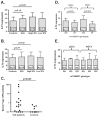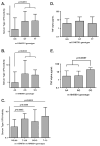Functional genetic polymorphisms in ILT3 are associated with decreased surface expression on dendritic cells and increased serum cytokines in lupus patients
- PMID: 22904259
- PMCID: PMC3910490
- DOI: 10.1136/annrheumdis-2012-202024
Functional genetic polymorphisms in ILT3 are associated with decreased surface expression on dendritic cells and increased serum cytokines in lupus patients
Abstract
Objective: Hyperactivity of the type I interferon (IFN) pathway is involved in the pathogenesis of systemic lupus erythematosus (SLE). Immunoglobulin like transcript (ILT3) is an immunohibitory transmembrane molecule which is induced by type I IFNs. ILT3 is expressed by plasmacytoid dendritic cells (PDCs), monocytoid dendritic cells (MDCs), and monocytes/macrophages. Given the pathogenic role of IFN in SLE, we hypothesised that the IFN-induced immunosuppressive ILT3 receptor may be dysfunctional in human SLE.
Methods: 132 European-derived and 79 Hispanic-American SLE patients were genotyped for two coding-change single nucleotide polymorphisms (SNPs) predicted to interfere with protein folding in ILT3 (rs11540761 and rs1048801). 116 control DNA samples and sera from healthy controls were also studied. We detected associations between ILT3 genotype and serum cytokine profiles. ILT3 expression levels on PDCs and MDCs from 18 patients and 10 controls were studied by flow cytometry.
Results: The rs11540761 SNP in the extracellular region was associated with decreased cell surface expression of ILT3 on circulating MDCs and to a lesser extent PDCs in SLE patients. The cytoplasmically located rs1048801 SNP was not associated with a change in dendritic cells expression of ILT3. Both SNPs were significantly and independently associated with increased levels of serum type I IFN activity in SLE patients. The rs1048801 SNP was also associated with increased serum levels of TNF-α.
Conclusions: Loss-of-function polymorphisms in ILT3 are associated with increased inflammatory cytokine levels in SLE, supporting a biological role for ILT3 in SLE.
Conflict of interest statement
Figures




Similar articles
-
Systemic lupus erythematosus patients have increased number of circulating plasmacytoid dendritic cells, but decreased myeloid dendritic cells with deficient CD83 expression.Lupus. 2008 Jul;17(7):654-62. doi: 10.1177/0961203308089410. Lupus. 2008. PMID: 18625638
-
Dysfunctional interferon-alpha production by peripheral plasmacytoid dendritic cells upon Toll-like receptor-9 stimulation in patients with systemic lupus erythematosus.Arthritis Res Ther. 2008;10(2):R29. doi: 10.1186/ar2382. Epub 2008 Mar 6. Arthritis Res Ther. 2008. PMID: 18321389 Free PMC article.
-
TLR9/TLR7-triggered downregulation of BDCA2 expression on human plasmacytoid dendritic cells from healthy individuals and lupus patients.Clin Immunol. 2008 Oct;129(1):40-8. doi: 10.1016/j.clim.2008.06.004. Epub 2008 Aug 5. Clin Immunol. 2008. PMID: 18684674
-
A compass that points to lupus: genetic studies on type I interferon pathway.Genes Immun. 2007 Sep;8(6):445-55. doi: 10.1038/sj.gene.6364409. Epub 2007 Jun 21. Genes Immun. 2007. PMID: 17581625 Review.
-
Sequential activation of conventional and plasmacytoid dendritic cells in autoimmune pancreatitis and systemic lupus erythematosus: similarities and dissimilarities.Front Immunol. 2025 Feb 18;16:1554492. doi: 10.3389/fimmu.2025.1554492. eCollection 2025. Front Immunol. 2025. PMID: 40040712 Free PMC article. Review.
Cited by
-
The nature of activatory and tolerogenic dendritic cell-derived signal II.Front Immunol. 2013 Feb 28;4:53. doi: 10.3389/fimmu.2013.00053. eCollection 2013. Front Immunol. 2013. PMID: 23450201 Free PMC article.
-
Type I interferon in the pathogenesis of systemic lupus erythematosus.Curr Opin Immunol. 2020 Dec;67:87-94. doi: 10.1016/j.coi.2020.10.014. Epub 2020 Nov 24. Curr Opin Immunol. 2020. PMID: 33246136 Free PMC article. Review.
-
Immunogenetics of systemic lupus erythematosus: A comprehensive review.J Autoimmun. 2015 Nov;64:125-36. doi: 10.1016/j.jaut.2015.08.004. Epub 2015 Aug 29. J Autoimmun. 2015. PMID: 26324017 Free PMC article. Review.
-
Functional and genetic diversity of leukocyte immunoglobulin-like receptor and implication for disease associations.J Hum Genet. 2015 Nov;60(11):703-8. doi: 10.1038/jhg.2015.64. Epub 2015 Jun 4. J Hum Genet. 2015. PMID: 26040207 Review.
-
Immunoglobulin-like transcript 3 is expressed by myeloid-derived suppressor cells and correlates with survival in patients with non-small cell lung cancer.Oncoimmunology. 2015 Mar 19;4(7):e1014242. doi: 10.1080/2162402X.2015.1014242. eCollection 2015 Jul. Oncoimmunology. 2015. PMID: 26140237 Free PMC article.
References
-
- Blanco P, Palucka AK, Gill M, et al. Induction of dendritic cell differentiation by IFN-alpha in systemic lupus erythematosus. Science. 2001;294:1540–3. - PubMed
Publication types
MeSH terms
Substances
Grants and funding
LinkOut - more resources
Full Text Sources
Medical

